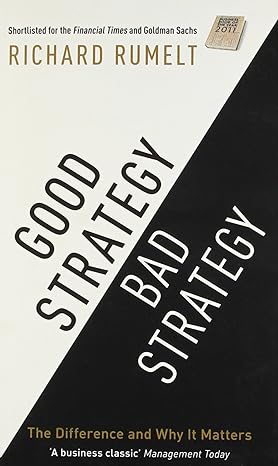Main Topic
“Good Strategy/Bad Strategy” by Richard P. Rumelt explores the concepts of strategy, emphasizing the importance of distinguishing between effective and ineffective strategies and their impact on organizations.
Key Ideas or Arguments
- The Core Idea: The book’s central idea is that a good strategy begins with a clear and honest assessment of the current situation, followed by the development of specific actions to achieve well-defined goals. This is in contrast to the common practice of creating vague and unproductive strategies.
- Kernel of Good Strategy: Rumelt introduces the concept of the “kernel of good strategy,” which includes three elements: diagnosis (identifying challenges), guiding policy (developing a plan), and coherent actions (execution).
- The Importance of Focus: The author stresses the significance of focusing on critical issues and prioritizing them to create a successful strategy.
- Case Studies: The book provides several real-world case studies to illustrate the principles of good and bad strategy in action, drawing lessons from organizations like Ford, the U.S. Navy, and the healthcare industry.
Chapter Titles or Main Sections
- What Is Strategy?: Examines the basic principles of strategy and distinguishes it from objectives and tactics.
- A Kernel of Good Strategy: Introduces the components of a successful strategy.
- Bad Strategy: Identifies common mistakes and pitfalls in strategy development.
- Sources of Power: Discusses how to leverage power and resources effectively in strategy.
- Using Leverage: Explores the role of advantage and leverage in shaping strategy.
- Proximate Objectives: Explains the significance of setting clear, achievable objectives.
- Hypotheses: Encourages a hypothesis-driven approach to strategy development.
- The Science of Strategy: Discusses the scientific aspect of strategy, including experimentation and learning.
Key Takeaways
- Good strategy is built on a foundation of clear diagnosis, guiding policy, and coherent actions.
- Avoid vague, wishful thinking and focus on defining and addressing critical issues.
- Real-world case studies provide valuable insights into effective and ineffective strategies.
Author’s Background and Qualifications
Richard P. Rumelt is a distinguished professor in the Anderson School of Management at the University of California, Los Angeles. He is a renowned expert in the field of strategy and has extensive experience consulting for various organizations.
Comparison to Other Books
Compared to other books on strategy, “Good Strategy/Bad Strategy” is highly regarded for its practical and actionable insights. It distinguishes itself by emphasizing the importance of diagnosing challenges and formulating clear policies, setting it apart from books that solely focus on strategy execution.
Target Audience
This book is primarily intended for business leaders, managers, and individuals involved in strategic planning and decision-making within organizations. It is also valuable for students and academics studying strategy.
Reception or Critical Response
“Good Strategy/Bad Strategy” has received widespread acclaim for its clarity and practicality in the field of strategy. It has been praised for its real-world examples and its ability to help readers develop a deeper understanding of effective strategic thinking.
Publisher and First Published Date
Published by Crown Business, the book was first published in 2011.
Recommendations
- “The Art of Strategy” by Avinash K. Dixit and Barry J. Nalebuff
- “Blue Ocean Strategy” by W. Chan Kim and Renée Mauborgne
- “Thinking, Fast and Slow” by Daniel Kahneman
Biggest Takeaway
A good strategy is one that starts with a clear diagnosis of challenges, followed by a well-defined guiding policy and coherent actions.



